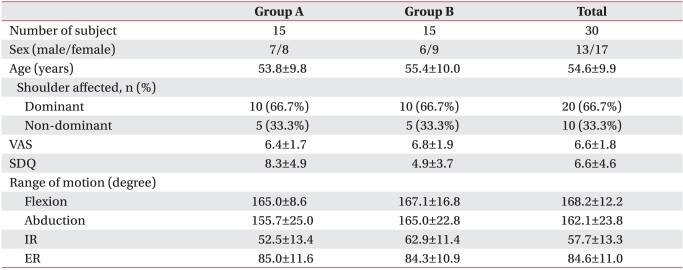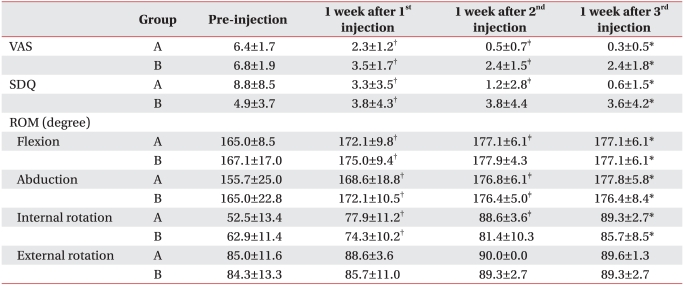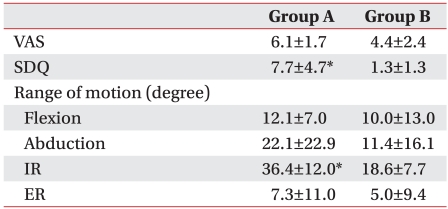1. Kim SB, Yoon K, Park HS, Kwak H, Ha NJ, Park JS, Gu BS. Ultrasonography in the shoulder impingement syndrome. J Korean Acad Rehabil Med. 2000; 24:542–550.
2. Yoon SH, Kwack KS, Rah UW, Cho KH. Ultrasonography-guided subacromial bursal injection of corticosteroid: a comparative study of two dose regimens. J Korean Acad Rehabil Med. 2009; 33:402–407.
3. Naredo E, Cabero F, Beneyto P, Cruz A, Monderjar B, Uson J, Palop MG, Crespo M. A randomized comparative study of short term response to blind injection versus sonographic guided injection of local corticosteroids in patients with painful shoulder. J Rheumatol. 2004; 31:308–314. PMID:
14760802.
4. Chen MJ, Lew HL, Hsu TC, Tsai WC, Lin WC, Tang SF, Lee YC, Hsu RC, Chen CP. Ultrasound-guided shoulder injections in the treatment of subacromial bursitis. Am J Phys Med Rehabil. 2006; 85:31–35. PMID:
16357546.

5. Blair B, Rokito AS, Cuomo F, Jarolem K, Zuckerman JD. Efficacy of injections of corticosteroids for subacromial impingement syndrome. J Bone Joint Surg Am. 1996; 78:1685–1689. PMID:
8934482.

6. Byun SD, Park DH, Jo DH, Choi WD, Lee ZI. Effect of three consecutive steroid injection on blood glucose and cortisol level in diabetic patients with hemiplegic shoulder pain. J Korean Assoc Pain Med. 2010; 9:82–89.
7. van Den Ende CH, Rozing PM, Dijkmans BA, Verhoef JA, Voogt-van der Harst EM, Hazes JM. Assessment of shoulder function in rheumatoid arthritis. J Rheumatol. 1996; 23:2043–2048. PMID:
8970039.
8. Kim C, Park YB, Youn JE, Kim DY. Treatment of adhesive capsulitis with steroid injection followed by hyaluronic acid injection. J Korean Acad Rehabil Med. 2010; 34:310–315.
9. Chou WY, Ko JY, Wang FS, Huang CC, Wong T, Wang CJ, Chang HE. Effect of sodium hyaluronate treatment on rotator cuff lesions without complete tears: a randomized, double-blind, placebo-controlled study. J Shoulder Elbow Surg. 2010; 19:557–563. PMID:
19963403.

10. Gourie-Devi M, Satishchandra P. Hyaluronidase as an adjuvant in the management of tuberculous spinal arachnoiditis. J Neurol Sci. 1991; 102:105–111. PMID:
1856727.

11. Lee KJ, Han SG, Yoon SH, Kim JS, Lee YS. Nerve root block with corticosteroids, hyaluronidase and local anesthetic in the failed back surgery syndrome (FBSS). J Korean Assoc Pain Med. 1999; 12:191–194.
12. Devulder J. Transforaminal nerve root sleeve injection with corticosteroids, hyaluronidase and local anesthetic in the failed back surgery syndrome. J Spinal Disord. 1998; 11:151–154. PMID:
9588473.

13. Seo JH, Lee RJ, Park SH, Na SY, Ko MH. The effect of intraarticular injection of hyaluronidase in patients with adhesive capsulitis of shoulder. J Korean Assoc Pain Med. 2006; 5:122–127.
14. Croft P, Pope D, Zonca M, O'Neill T, Silman A. Measurement of shoulder related disability: results of a validation study. Ann Rheum Dis. 1994; 53:525–528. PMID:
7944638.

15. Cho KH, Gee SJ, Lee HJ, Hwang SH. Comparison of blind technique and ultrasonography guided technique of subacromial subdeltoid bursa injection. J Korean Acad Rehabil Med. 2010; 34:209–213.
16. Tillander B, Franzen LE, Karlsson MH, Norlin R. Effect of steroid injections on the rotator cuff: an experimental study in rats. J Shoulder Elbow Surg. 1999; 8:271–274. PMID:
10389085.

17. Akpinar S, Hersekli MA, Demirors H, Tandogan RN, Kayaselcuk F. Effects of methylprednisolone and betamethasone injections on the rotator cuff: an experimental study in rats. Adv Ther. 2002; 19:194–201. PMID:
12431045.

18. Menzel EJ, Farr C. Hyaluronidase and its substrate hyaluronan: biochemistry, biological activities and therapeutic uses. Cancer Lett. 1998; 131:3–11. PMID:
9839614.

19. Remy M, Pinter F, Nentwich MM, Kampik A, Schönfeld CL. Efficacy and safety of hyaluronidase 75 IU as an adjuvant to mepivacaine for retrobulbar anesthesia in cataract surgery. J Cataract Refract Surg. 2008; 34:1966–1969. PMID:
19006746.

20. Doumouchtsis SK, Boama V, Gorti M, Tosson S, Fynes MM. Prospective evaluation of combined local bupivacaine and steroid injections for the management of chronic vaginal and perineal pain. Arch Gynecol Obstet. 2011; 284:681–685. PMID:
21079978.

21. Kwon DR, Kim MY, Chae YJ, Park JS, Kim JS, Yi TI. Comparison of coracohumeral ligment thickness between asymptomatic shoulders and adhesive capsulitis in Korean. J Korean Acad Rehabil Med. 2009; 33:392–395.
22. Kang TD, Hwang DH, Jung KI, Park DS, Jang KE. Ultrasonography in adhesive capsulitis of shoulder. J Korean Acad Rehabil Med. 1998; 22:944–949.







 PDF
PDF ePub
ePub Citation
Citation Print
Print



 XML Download
XML Download